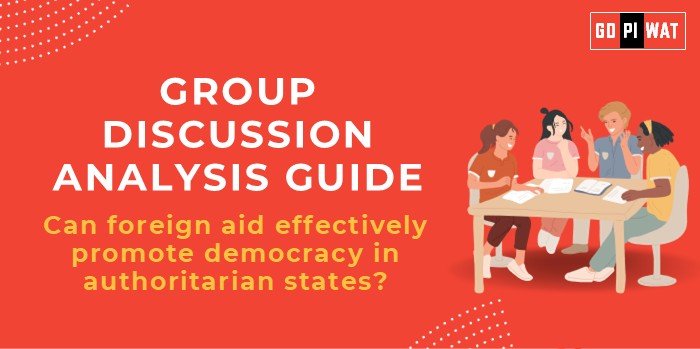📋 Group Discussion Analysis Guide: Can Foreign Aid Effectively Promote Democracy in Authoritarian States?
🌐 Introduction to the Topic
📖 Opening Context
Foreign aid, often viewed as a tool for development and diplomacy, is frequently utilized by democratic nations to encourage democratic transitions in authoritarian regimes. This practice raises critical questions about its effectiveness and potential unintended consequences.
📜 Topic Background
The idea that aid can foster democracy is rooted in post-Cold War strategies where Western nations linked financial assistance to political reforms. However, the track record has been mixed, with successful examples in Eastern Europe and failures in parts of Africa and the Middle East.
📊 Quick Facts and Key Statistics
- 💰 Annual Global Aid Budget: Over $150 billion (OECD, 2023).
- 📈 Democratic Transitions Linked to Aid: 42% success rate in the past two decades (World Bank, 2023).
- 🛡️ Authoritarian Countries Receiving Aid: Over 60% of global aid recipients operate under authoritarian regimes.
- 🌍 Case in Point: Tunisia’s democratic progress post-Arab Spring, partly supported by $2 billion in aid from the EU and US.
🤝 Stakeholders and Their Roles
- 🏛️ Donor Nations: Primarily Western democracies like the US and EU member states, offering financial aid tied to democratic benchmarks.
- 🌐 Authoritarian Governments: Recipients of aid with varying degrees of commitment to democratic reforms.
- 📢 International Organizations: UN, World Bank, and NGOs play mediating roles, providing expertise and resources while advocating for democratic governance.
- 👥 Civil Society: Local groups leverage aid to push for reforms, often facing repression.
🏆 Achievements and Challenges
✨ Achievements
- 🇵🇱 Eastern Europe: Poland and Hungary transitioned towards democracy with substantial EU funding in the 1990s.
- 🇹🇳 Tunisia: Post-2011 reforms supported by aid significantly bolstered democratic institutions.
⚠️ Challenges
- 💸 Misuse of Funds: Aid often strengthens authoritarian regimes due to corruption.
- 🤝 Geopolitical Interests: Donors may prioritize strategic alliances over democratic outcomes.
- 🌍 Global Comparison: While aid succeeded in Eastern Europe, its impact was limited in countries like Egypt and Zimbabwe.
💡 Structured Arguments for Discussion
- 🛠️ Supporting Stance: “Foreign aid catalyzes democracy by funding civil society, ensuring fair elections, and promoting human rights.”
- 🛡️ Opposing Stance: “Aid entrenches authoritarian leaders who manipulate funds to suppress dissent.”
- ⚖️ Balanced Perspective: “Aid’s effectiveness depends on recipient accountability and donor strategy alignment with local realities.”
🎯 Effective Discussion Approaches
🔑 Opening Approaches
- 📊 Comparative Data: “Countries receiving democracy-linked aid had a 42% success rate in transitions…”
- 📖 Case Study: “Tunisia’s democratic success highlights aid’s potential.”
⚙️ Counter-Argument Handling
- 🔄 Acknowledge: “Egypt’s misuse of aid is a valid concern.”
- ✅ Rebuttal: “However, cases like Poland demonstrate the transformative power of aid when tied to accountability.”
🧠 Strategic Analysis of Strengths and Weaknesses
SWOT Analysis:
- 💪 Strengths: Provides financial resources, technical expertise, and international oversight.
- 🛠️ Weaknesses: Risk of misuse and donor self-interest.
- 🌟 Opportunities: Strengthening local governance, fostering regional stability.
- ⚠️ Threats: Backlash from authoritarian governments, public perception of interference.
🏫 Connecting with B-School Applications
📚 Real-World Applications
- 🌍 Understanding foreign aid’s role in global governance aligns with studies in international business and diplomacy.
🎓 Sample Interview Questions
- ❓ “How can aid balance democracy promotion with respect for sovereignty?”
- ❓ “Discuss a successful and a failed instance of democracy promotion via aid.”
💡 Insights for Students
- 📈 Explore project ideas on sustainable aid mechanisms, political economy, or cross-cultural negotiation strategies.


